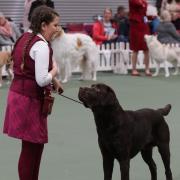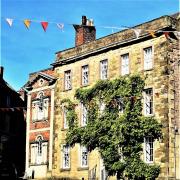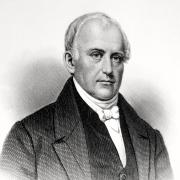This month’s foray into Derbyshire’s folklore focuses on the weird world of animals, encompassing tall tales, cryptozoology (defined by the Oxford English Dictionary as ‘The study of unknown, legendary, or extinct animals whose existence or survival to the present day is disputed or unsubstantiated’), and instances where the presence of non-native species have brought an unexpectedly exotic touch to the county.
In June 1897, a fantastical creature was shot and killed. An item appeared in the High Peak News of June 26 under the headline ‘EXTRAORDINARY CAPTURE AT WINSTER: A TOMCAT WITH WINGS’.
It reads: ‘The most interesting item in natural history, so far as the Matlock district is concerned, transpired this morning. Our reporter learns Mr Roper of Winster, while on Brown Edge near that village, shot what he thought to be a fox, which had been seen in the locality some time previously, on Mr Foxlow’s land.

‘Thinking he had missed his aim, Mr Roper gave up the quest, but returning later found he had killed the animal. It proved to be an extraordinarily large tomcat, tortoiseshell in colour with fur two and a half inches long, with the remarkable addition of fully-grown pheasant wings projecting from each side of its fourth rib.’
Sadly, this unusual cat-pheasant hybrid was not preserved for future study.
‘Unfortunately, the climate having been so excessively hot, the animal was allowed to putrefy, and after being generally exhibited all round the district the carcase has now been interred. It was seen by Mr Joseph Hardy and ample witnesses, so there is no doubt the museums have missed a most curious animal.
‘Never has its like been seen before, and eye-witnesses state that when running the animal used its wings outstretched to help it over the surface of the ground, which it covered at a tremendous pace’.
Winged cats are a recognised phenomenon to the extent they merit their own Wikipedia page, which notes depictions of cats sprouting wings can be found as far back as prehistoric artwork.
The entry observes 138 recorded incidents, the most recent from Tatarstan, Russia, in 2011, and offers possible medical explanations for the phenomenon.
A cruel former superstitious custom when building a property was to wall up a live cat in the fabric of the building to bring good luck (to the inhabitants – clearly, not to the cat).
These pitiful sacrifices are subsequently discovered years later in mummified form – presumably quite a shock for the finder.
An example can be seen in a glass display case at Three Stags’ Heads pub at Wardlow Mires; found in the fabric of the building (which dates to 1740) during renovations in the 1920s.

Buxton Museum are custodians of a similar mummified cat, donated in 2017 by local Maxine Chuwen, following its discovery when a nearby building in The Quadrant formerly used as a Post Office was renovated - it fell out the ceiling onto the unfortunate builders below.
A mummified cat was also discovered at a former silk and velvet mill in Crown Yard, Wirksworth, whilst the building was being converted to the town’s Heritage Centre (since relocated to St John’s Street).
A fourth local example was unearthed in 2020 when James and Kirsty Corbett were renovating a barn from the 1820s on their property in Nether Heage.
Mysterious large black panther-like cats have frequently been sighted in Derbyshire, including Ashbourne, Flagg, Chapel-en-le-Frith, Amber Valley, Derby, Carsington, Wirksworth, Crich and Monsal Trail areas.
In 1989 six police marksmen were dispatched to Ollersett Moor near Hayfield and hikers advised to avoid the area following a sighting of such a creature.
In 2009 Adam Gladwin saw one near Whitworth Park, Darley Dale, whilst cycling to work at 5am, and they have also been spotted in the nearby Northwood area.
In the early 2000s there were several sightings of a large black cat in the Matlock area, which the local press christened the Beast of Riber.
There was speculation it could have escaped or been deliberately released from the zoo, which operated in the grounds of Riber Castle following its closure in the year 2000.
Such an occurrence is by no means unheard of. Around Stanton-in-the-Peak and South Darley, a herd of an unusual black strain of Norwegian fallow deer live wild.

Close by is Stanton Hall, seat of the Thornhill family. The 1867 Some Account of English Deer Parks notes the hall’s deer park was established in 1800, with the deer introduced from the ancient park of Chartley, Staffordshire.
Local builder Lewis Jackson in his memoir My Darley and Beyond records how this wild deer population came to be.
‘In the 1970s/80 we carried out building work for the Thornhills of Stanton Hall… Nicholas Thornhill told me Stanton Hall had a deer park with around 40 to 50 deer until 1944 and when Britian was becoming short of food the Thornhills were served with an order to cull the deer and plough up and cultivate the deer park. When the dreadful day arrived… Nicholas told me, with a twinkle in his eye, that somehow they had all escaped the night before and were nowhere to be found.’
Even more bizarrely, a population of feral wallabies existed in the Peak District for many years, based in the Staffordshire Roaches area - although some made their way over the border, with sightings in the Goyt Valley and near Chapel-en-le-Frith and Buxton.
These were descendants from creatures kept at a private zoo on Staffordshire’s Swythamley estate by the animal-loving local squire, Henry Courtney Brocklehurst.
Following a fire several escaped and whilst most were recaptured, some laid low, subsequently adapting to their new moorland habitat and breeding.
A 2013 article in British Wildlife journal by Derek Yalden, The end of feral wallabies in the Peak District, posits that following a population decline towards the end of the 20th century, the final remaining wallaby originating from the escapees died in 2009.
Wolves are thought to have become extinct in England by the reign of Henry VII (1485–1509). Local legend says the country’s last wolf was slain in the grounds of Wormhill Hall – although other locations in the North of England make the same claim.
In her memoir of county life, Ambush of Young Days, authoress Alison Uttley, who grew up at Castle Top Farm near Cromford, records a strange incident that happened to her father whilst ploughing.
The plough unearthed a large boulder which her father and brother set upon breaking with a pick, only to discover a hollow at the centre inside in which was concealed a live frog. It hopped out, and promptly crumbled to dust.
The incident puzzled Uttley’s father for the rest of his life given there was no crack in the rock through which the amphibian could receive air, leaving him to wonder if it had been living inside since the rock was formed.
No one, including, presumably, his scientifically-minded daughter (after attending Bakewell’s Lady Manners School she gained a scholarship to study Physics at Manchester University - only their second female graduate in this discipline in 1906) was able to offer a satisfactory explanation.

Perhaps my favourite piece of animal lore I’ve collected is a local example to me, from the village of Two Dales where I grew up - and probably marks the first time it has appeared anywhere in print.
It originates from a cassette tape housed in the archives of Sheffield University as part of the collection of material gathered by Dave Bathe, former Winster Morris dancer and guiser.
Dave recorded interviews with elderly Derbyshire residents about their memories of local folklore and customs, and this tale comes from an interview with George Walters, 85 at the time of recording in 1984.
As the tape rolled, George recalled a strange incident his mother told him about which had happened over 100 years previously.
‘Me mother knew a case, when there were some men poaching on the Sunday morning on the hillside here, and there was three men, and they saw an apparition. They said they saw a rabbit as big as a dog, and his eyes as big as saucers. And one man dropped dead. And that was true – me mother said they carried the man down the road on a gate to the Blacksmith’s Arms. She said she saw them carrying this man down – a man named Fox. I think the others were two brothers named Platts. And it was one of the Platts that died… they worked under the man that owned the ground, and they was afraid of getting sack. They took them to court, but they let them off, they said they’d suffered sufficient. It was fear, you see. It sounds a tall order, but I can believe my mother, you know.’
Having grown up on a cultural diet of psychedelic 1970s British comedy, I am now envisaging something akin to a cross between Monty Python’s Killer Rabbit and The Goodies’ Kitten Kong stalking the hillside above my home village… Don’t have nightmares.



























